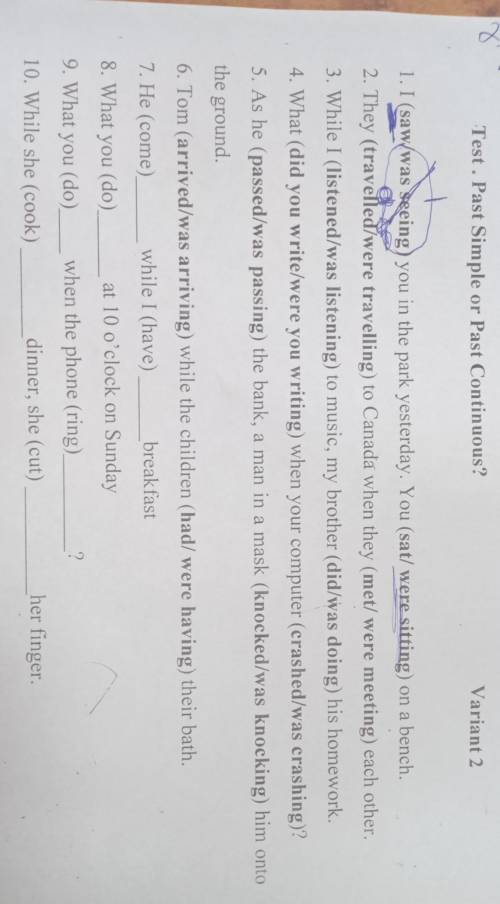Variant 2 Test. Past Simple or Past Continuous?
1. I saw/was seeing you in the park yesterday. You (sat/ were sitting) on a bench.
2. They (travelled/were travelling) to Canada when they (met/ were meeting) each other.
3. While I (listened/was listening) to music, my brother (did/was doing) his homework.
4. What did you write/were you writing) when your computer (crashed/was crashing)?
5. As he (passed/was passing) the bank, a man in a mask (knocked/was knocking) him onto
the ground.
6. Tom (arrived/was arriving) while the children (had/ were having) their bath.
7. He (come)
while I (have) breakfast
8. What you (do)
at 10 o'clock on Sunday
9. What you (do)
when the phone (ring)
?
10. While she (cook)
dinner, she (cut)
her finger.

Другие вопросы по теме Английский язык
Популярные вопросы
- нужно написать сообщение на тему Болезни органов слуха...
3 - Составте небольшую цепочку, чтобы получить из кремния силикат меди...
1 - 13 вересня 1937 року наступ на шанхай здійснила армия...
1 - Как вы знаете, рабочие Древнего Египта при строительстве пирамид...
1 - ответь на во по графику функции. 1 клеточка = 4 единицам. bildiite.PNG...
1 - Назвіть особливості водного середовища життя...
1 - Какие из неравенств верны? 1) −9 ≥ −7 2) 2 ≥ -2 3) 6, 129 6,131 4)...
2 - Визначте масову частку Оксигену (%) в манган VI оксиді...
1 - Вариант 2 А1. Назовите годы жизни А.А. Ахматовой а) 1892-1941 б)...
3 - Визначіть відносну вологість повітря при температурі 15 °С, якщо...
2
Explanation: This sentence describes two past actions happening at the same time. The action of seeing (saw) happened in the past, while the action of sitting (were sitting) was ongoing in the past. We use the past continuous tense (were sitting) to describe an action that was already in progress in the past.
2. The correct answer is "They were traveling to Canada when they met each other."
Explanation: This sentence also describes two past actions happening at the same time. The action of traveling (were traveling) was ongoing in the past, while the action of meeting (met) happened at the same time. Again, we use the past continuous tense (were traveling) to describe an action in progress and the simple past tense (met) for a completed action.
3. The correct answer is "While I was listening to music, my brother was doing his homework."
Explanation: This sentence describes two past actions happening at the same time. The action of listening (was listening) was ongoing in the past, while the action of doing (was doing) was also ongoing at the same time. The past continuous tense is used for both actions.
4. The correct answer is "What were you writing when your computer crashed?"
Explanation: This sentence describes two past actions happening simultaneously. The action of writing (were you writing) was in progress when the action of the computer crashing (crashed) occurred. We use the past continuous tense (were you writing) for the ongoing action and the simple past tense (crashed) for the completed action.
5. The correct answer is "As he was passing the bank, a man in a mask knocked him onto the ground."
Explanation: This sentence describes two past actions happening at the same time. The action of passing (was passing) was ongoing in the past when the action of knocking (knocked) took place. The past continuous tense (was passing) is used for the ongoing action, and the simple past tense (knocked) describes the completed action.
6. The correct answer is "Tom arrived while the children were having their bath."
Explanation: This sentence describes two past actions happening at the same time. The action of arriving (arrived) happened in the past when the action of having a bath (were having) was ongoing. The past continuous tense (were having) is used for the ongoing action, and the simple past tense (arrived) describes the completed action.
7. The correct answer is "He came while I was having breakfast."
Explanation: This sentence describes two past actions happening at the same time. The action of coming (came) happened in the past when the action of having breakfast (was having) was ongoing. The past continuous tense (was having) is used for the ongoing action, and the simple past tense (came) describes the completed action.
8. The correct answer is "What were you doing at 10 o'clock on Sunday?"
Explanation: This question asks about a specific time in the past (10 o'clock on Sunday). We use the past continuous tense (were you doing) to describe an action that was in progress at that specific time.
9. The correct answer is "What were you doing when the phone rang?"
Explanation: This question asks about an action that happened in the past (the phone rang). We use the past continuous tense (were you doing) to describe the ongoing action that was interrupted by the ringing phone.
10. The correct answer is "While she was cooking dinner, she cut her finger."
Explanation: This sentence describes two past actions happening simultaneously. The action of cooking (was cooking) was ongoing in the past when the action of cutting (cut) happened. The past continuous tense (was cooking) is used for the ongoing action, and the simple past tense (cut) describes the completed action.